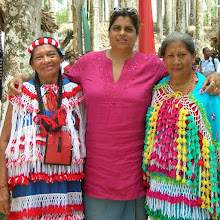 Sholay
Sholay. Deze film over moed, vriendschap en liefde heeft als tienjarig meisje zo'n diepe indruk op me gemaakt, dat het waarschijnlijk de rest van mijn leven in mijn top 3 van Indiase films blijft staan. Het nummer ‘Yeh Dosti, Hum Nahin Torenge’ (Deze vriendschap zal ik nooit verbreken) is een ode aan de ware diepte van echte kameraadschap, of om het met een hipper woord te omschrijven: brotherhood.
Sholay was een kassucces en tevens de film waarmee Amitabh Bachchan doorbrak bij het grote publiek. Vrouwen vielen bij bosjes voor zijn lengte, stem, donkere volle haar en het eergevoel dat hij in zijn rollen zo goed wist te brengen. Voor mannen was hij een nieuw rolmodel: ze wilden op hem lijken, mede om hun succes bij de vrouwen te vergroten. Hij deed romantische tijden herleven.
Ik zag de film in Theater De Paarl in Paramaribo (Zorg en Hoop), de hoofdstad van mijn geboorteland Suriname. Er moesten losse stoelen in de gangen worden bijgezet. Er waren namelijk te veel kaartjes verkocht: men wilde het toegestroomde publiek dat zijn/haar mooiste kleren had aangetrokken voor zo'n zondagse
meet & greet in de bioscoop niet teleurstellen. Want dat was wat bioscoopbezoek in Suriname betekende, voordat de avondklok van bevelhebber Bouterse in combinatie met de komst van de video de vele filmhuizen kapot maakten, en daarmee het bijbehorende bruisende sociale leven. Theater De Paarl was het gebouw waar nu disco Zsa Zsa Zu in is gevestigd. Nu staan er elk weekend lange rijen voor de kassa van de discotheek, vroeger stonden er lange rijen met allemaal mooi geklede mensen voor de kassa van de bioscoop, volwassenen en kinderen door elkaar. Je ging met opzet eerder om er zeker van te zijn dat je een kaartje kon bemachtigen, maar ook om vrienden en familie te ontmoeten en soft, chips of popcorn te kopen. En als je naar het chique Theater Star (met rode pluchen stoelen) of het destijds nieuwe Cinema City was gegaan, kon je in de hal staan genieten van het bioscoopgevoel.

Kun je je voorstellen hoe ik me voelde toen ik Amitabh himself mocht interviewen, in het Krasnapolsky Hotel in Amsterdam, zo’n zeventien jaar na mijn gezwijmel als tienjarige in De Paarl? Nooit gedroomd of gedacht dat zoiets zou kunnen gebeuren; het is bijna onbeschrijfelijk hoe allerlei belevingswerelden op dat moment samenkwamen. Die dag wist ik zeker dat ik er goed aan had gedaan om het journalistieke pad in te slaan. Als een herinnering aan dat interview heb ik vier zwart-wit foto’s aan de muren van mijn huis hangen: twee waarop we samen staan, twee waarop hij alleen te zien is. Mijn artikel werd gepubliceerd in het nationale dagblad
Trouw en werd gekopieerd door de Surinaamse krant
De Ware Tijd; het was groot nieuws dat iemand uit de eigen Surinaamse gelederen deze grote ster had geïnterviewd. Na
Sholay is hij uitgegroeid tot The Big B., een handelsmerk voor de Indiase cinema, een graadmeter voor succes. In de latere jaren van zijn carrière is hij ook geëngageerde films gaan maken, zoals
Black met Rani Mukherjee. Je kunt veel over hem zeggen, behalve dat hij saai is. He lives life to his fullest potential.
Sinds kort heb ik een bioscoop in Amsterdam gevonden waar ik af en toe films kan programmeren. Afgelopen maand ben ik begonnen met
Laaga Chunari Mein Daag (met Rani Mukherjee).
Sholay staat op mijn shortlist. Intussen ben ik mensen van Iraanse, Marokkaanse, Turkse, Indiase, Nederlandse, Surinaamse en vele andere achtergronden tegen gekomen, allemaal met dezelfde liefde: de Indiase film. En om preciezer te zijn: voor
Sholay. Op een dag zullen we samen in het donker de
road to memory lane betreden, ons laten vertederen door Basanti (Hema Malini), weer onder de indruk raken van de gemene streken van de gemene boef Gabbersingh (Amjad Khan). We zullen allemaal verlangen naar dat moment waar Amitabh Bachchan en Dharmendra hun liedje 'Yeh Dosti, Hum Nahin Torenge' playbacken en glimlachend luisteren en kijken naar deze ode aan de vriendschap. Deze keer misschien met tranen in onze ogen, want de personages van
Sholay zijn immers onze geliefde vrienden geworden. Maar nu hebben we voorkennis: we weten al hoe het verhaal zal aflopen.
 Looking at this photo makes me happy, I can stare at it for hours, making up all sorts of stories in my head. The relationship between the boy and elephant moves me in a special way, softens my heart. See how the elephant has put his legs together and is present with his full being? Oké, that is my fantasy at work... But for sure, it is one of the nicest pictures I've ever seen, or better said, experienced. Photographer is Gregory Colbert.
Looking at this photo makes me happy, I can stare at it for hours, making up all sorts of stories in my head. The relationship between the boy and elephant moves me in a special way, softens my heart. See how the elephant has put his legs together and is present with his full being? Oké, that is my fantasy at work... But for sure, it is one of the nicest pictures I've ever seen, or better said, experienced. Photographer is Gregory Colbert.










